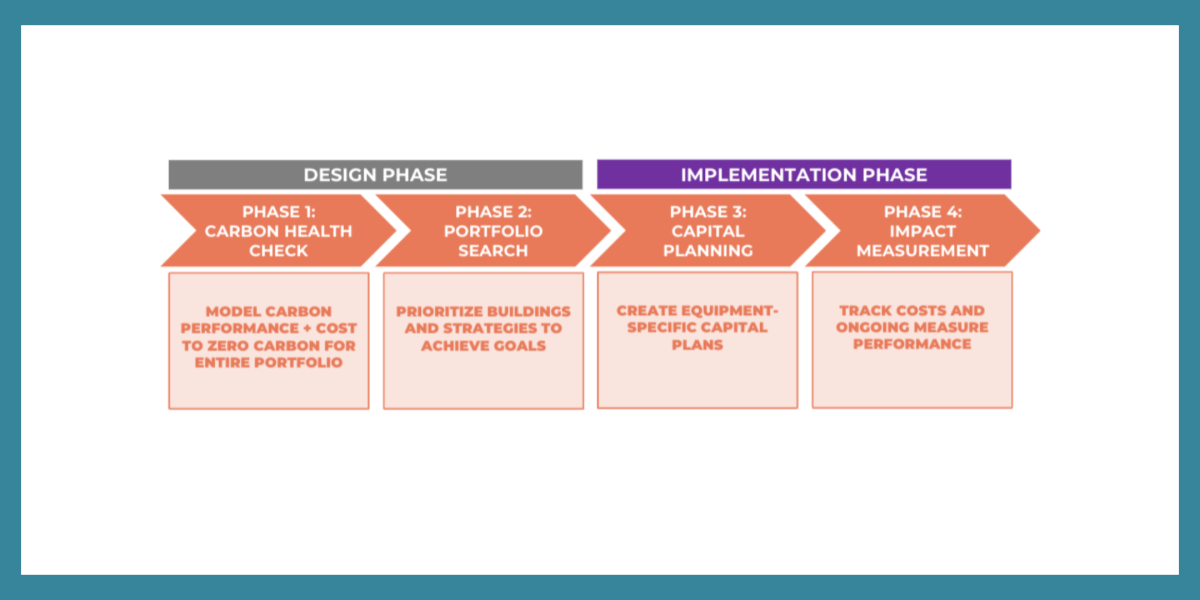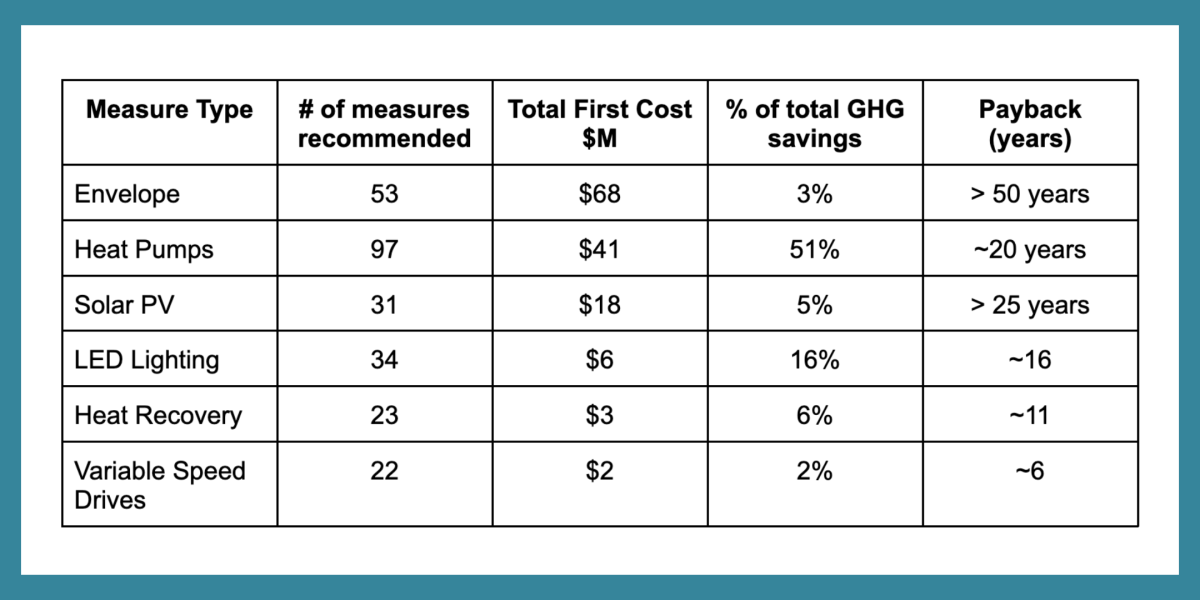
Founded in 2019, Audette is a Canadian proptech company with a mission to create a Carbon Reduction Plan for every building on the planet. They offer an advanced analytics platform that accelerates carbon reduction investments in commercial buildings. With their proprietary technology, Audette provides effective strategies based on real data to expedite decarbonization at the ground level and drive global impact. Their platform uses utility and equipment data to analyze a building's operation and produces recommendations to improve carbon performance, making it a powerful tool in the fight against climate change.
The CleanBC Building Innovation Fund was instrumental to Audette’s technology development efforts, where automated approaches to building decarbonization planning were piloted as part of a 47-building demonstration project.
The Pilot
Commercial real estate asset managers are under increasing pressure from investors to demonstrate credible decarbonization plans across their portfolios and are looking for ways to quickly identify and prioritize carbon reduction opportunities. New approaches to building decarbonization planning and energy auditing have emerged, allowing for more interactive and easily updated processes. These new methods are cost-effective and efficient, providing a more streamlined approach to traditional engineer-driven methods.
Audette partnered with the Building Owners and Managers Association of BC (BOMA BC) who identified six property management firms with a presence in BC’s Lower Mainland to conduct a proof-of-concept pilot on a scalable approach to carbon management within commercial buildings. The aim of the pilot project was to demonstrate the value of an automated analysis approach to decarbonization planning. Each building’s plan was refined through the progressive addition of aerial/street-level imagery, real-world energy performance from utility bills, and data collection through surveys.
The sample of buildings analyzed for the pilot comprised of:
- 47 Buildings (including 26 office, 10 retail buildings, 8 MURBs, and 2 warehouses)
- Over 880,000 sq-m (9.5M sq-ft) of gross floor area
- Approximately 19,000 tonnes of CO2e in estimated annual emissions
- Over $11M in estimated annual utility costs
Approach
Audette's analysis uses graduated intelligence to create a preliminary decarbonization plan for any building in a customer's portfolio, based on key data points. Though initially less accurate, this approach provides a starting point for customers to understand the carbon risk (carbon exposure, or valuation risks due to market pressures for low-carbon real estate) associated with their buildings. To increase their confidence in the plans, users can supplement their building’s profile with additional data points, including (but not limited to):
- Historical utility bills
- Equipment data
- Rooftop unit (RTU) and air-handling unit (AHU) inventories (pre-populated via aerial imagery models)
- Equipment ages
- Heating/cooling capacities and efficiencies
- Internal load data
- Operating schedules
- Lighting fixtures and control schedules
- Unusual/unique process loads

Creating a Carbon Reduction Plan. Credit: Audette
Once a building’s profile is populated with all available information, a decarbonization plan is generated by applying best practices and industry-standard decarbonization methodologies from the commercial real estate sector, generally comprised of the following steps:
- Reduce heat loss - for example, reduce air leakage, increase insulation.
- Recover waste heat - for example, exhaust air heat recovery, drain water heat recovery.
- Replace inefficient and GHG-intensive equipment - for example, replace old fossil-gas boilers with high-efficiency air-to-water heat pumps.
Each plan contains a set of recommendations, with each measure applied at an appropriate milestone (when replacing existing fossil-fuel fired equipment, or right away if economics are favourable). Project-level financials account for:
- Carbon reduction measure costs,
- Local utility costs, including future escalation,
- Future carbon price trajectories,
- Electricity grid GHG intensities, and
- Future decarbonization scenarios.
Aggregated Results
Through a pilot project of 47 buildings, decarbonization plans were developed and resulted in the following aggregated results:
- Over 350 unique carbon reduction measures recommended.
- Total project costs of $180M, half of which were incremental costs over business-as-usual scenarios (like-for-like replacement).
- Total projected annual GHG savings of over 10,300 tonnes CO2e, with an average above 70% reduction in CO2 emissions at the building level.
- Average marginal CO2 abatement cost of approximately $190/tonne.
Building-Level Results
The aggregated results above are synthesized from building-level decarbonization plans. Large portfolio managers may want to use aggregated results for high-level budget planning and project prioritization prior to diving into building-level planning. Using the results of the 47 buildings in the pilot, the following decarbonization measures were identified as the best retrofit opportunities for commercial buildings in BC. The financial metrics expressed below reflect a sample that is skewed toward office buildings.

Common retrofit opportunities for commercial buildings in BC. Credit: Audette
Largest Capital Deployments
- Envelope Upgrades (Roof Insulation, Windows)
Envelope upgrades accounted for $68M (35%) of the total $180M in project costs identified for this pilot project but were limited to roof insulation and glazing upgrades given the significant implementation complexity and marginal carbon improvement related to opaque wall upgrades. Both roof insulation and glazing were assumed to take place near the end-of-life of these systems and were costed out incrementally to the “like-for-like” replacement scenario. These measures typically did not have attractive financial metrics on their own; however, the analysis considers the impacts of improved envelope performance on future HVAC equipment system sizing, and thus more accurately depicts overall decarbonization costs.
- Heat Pumps
Given the very low GHG intensity and per-kWh cost of grid electricity in BC, the electrification of space and domestic water heating results in significant GHG and cost savings when replacing fossil gas-fired equipment. As a result, air-to-air and air-to-water heat pumps were commonly recommended, with $41M of project costs across the 47 buildings . Electric heat pump rooftop units (RTUs) were recommended to replace gas-fired RTUs, while electric air-to-water heat pumps were recommended as replacements to centralized gas-fired boilers. In both cases, heat pumps are sized to reflect reduced peak loads from any previously-implemented load-reduction measures (e.g. high-performance windows), resulting in lower capital costs than a traditional “like-for-like” replacement analysis would suggest. Partially for this reason, the average marginal CO2 abatement cost was roughly $100 of savings per tonne over the lifetime of the equipment (including utility rate and carbon price escalations).
- Rooftop Solar PV
Solar PV is recommended in significant quantities, given it is a zero-emissions renewable resource and can contribute to peak cooling demand management. Due to the low per-kWh and GHG intensity of the BC grid, solar PV is not particularly attractive financially or on a marginal abatement cost basis - however, if the building sector is to succeed in the large-scale electrification of fossil-fueled end uses (e.g. space/water heating), supporting energy systems will need as much clean energy supply as possible for the foreseeable future, and thus PV is recommended wherever rooftop area permits.
Best Financial Returns
- Variable Speed Drives
Another staple of traditional energy audit reports, variable speed drives (VSDs) were assumed to save a fixed percentage of the estimated fan and pump energy requirements of each building. Similar to LED Lighting, variable speed drives can reduce peak demands on electrical distribution systems, freeing up capacity for electrification of other end uses without expensive service upgrades.
- Heat Recovery
This category of measures included several waste heat recovery strategies, primarily exhaust air heat recovery, but also including heat recovery on drain water/wastewater, commercial refrigeration, and kitchen ventilation. In cases where existing equipment was not recommended for replacement, the addition of “in-situ” retrofit heat recovery strategies was recommended, including glycol runaround loops, or novel compressor-based exhaust air heat recovery systems. In cases where utility data indicated significant simultaneous cooling and heating loads, heat recovery chillers were recommended.
- LED Lighting
A staple of traditional energy audit reports, LED lighting is widely recommended throughout this pilot study. Contributing 16% of the overall GHG savings, the payback period is somewhat longer than typical in the building efficiency industry due to the relatively low cost of electricity in BC. LED lighting has the added benefit of reducing internal heat gains from lighting (reducing cooling demand), while also potentially frees up electrical capacity for HVAC system electrification without the need for costly service upgrades.
Key Retail Measures
LED lighting is a key measure in retail settings due to the high lighting power densities and longer operating schedules relative to other building types. For this reason, average paybacks in retail settings were roughly six to seven years, compared to a typical payback of 20 years in an office building.
Key Office Measures
Waste heat recovery is an effective measure in office settings, due to high equipment and occupant densities and lower surface-to-volume ratios, which tend to increase internal gains and decrease space heating loads per unit of floor area. As a result, waste heat recovery measures contributed approximately three times more carbon emissions savings (per sq-m of floor area) in office buildings than in retail.
Key Findings
This pilot study revealed several key lessons learned:
- Customer data is often inconsistent and incomplete
The availability and quality of building-level data can vary widely, even within the portfolio of a Class A asset manager. In some cases, full equipment data and whole-building utility data was available - in other cases, little more than a CAPEX plan was available. Audette was able to provide value in all cases by filling in data gaps with industry-standard assumptions and highlighting these assumptions to pilot project participants.
- Integration with customer processes is key
Users want actionable data that can be easily integrated into their existing internal processes and shareable across people and departments. A focus on integration with other property management platforms (e.g. ENERGY STAR Portfolio Manager, MRI Angus) and reporting processes (e.g. BOMA BEST, GRESB) would be beneficial.
- Embodied carbon is not front-of-mind (yet)
The implications of embodied carbon did not seem to be front-of-mind for many of the pilot project participants. This finding suggests the opportunity for further education within the building industry about these important implications, particularly as it relates to envelope measures. The lack of environmental product declarations for mechanical and electrical equipment is a major obstacle to incorporating embodied carbon considerations in the reduction of operational emissions
Closing Thoughts
Results of the CleanBC Building Innovation Fund pilot project demonstrated the value of automated approaches to building decarbonization planning. The analyses indicated that decarbonization plans could be generated for different building uses (office, retail, multi-unit residential buildings), archetypes (low-rise and high-rise), and HVAC configurations (centralized vs. distributed), with a unique set of recommended measures and decarbonization costs for each. Using the learnings from this pilot, Audette continues to develop and enhance their platform to deliver impactful decarbonization plans that allow customers to engage with and refine their results with new data points.
For property owners and managers, tools like Audette can provide valuable information integrating capital renewal and decarbonization planning while providing a business case to justify the investment. Insights from the analysis can help inform capital investment planning and highlight opportunities to bundle specific retrofits to achieve carbon emission targets, manage utility costs and achieve non-energy objectives. Replacing fossil fuel equipment with electric heat pumps presents the best opportunity to achieve deep, immediate and real emissions reductions. Where improved envelope performance results in a reduction to equipment size, proper sequencing is paramount to energy and emissions savings.
With both portfolio and building-level decarbonization plans, building owners will have information critical to smart investment across their portfolio and ensure they are modernizing their buildings to meet evolving standards.
A B2E Publication written by Brett Kerrigan, Audette
 b2e@zeic.ca
b2e@zeic.ca


